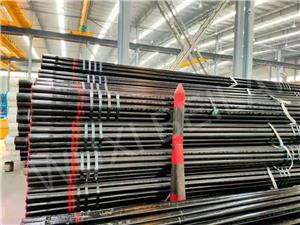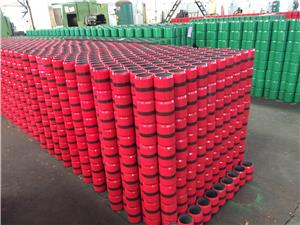What are the requirements for material selection for externally thickened EUE tubing?
Mechanical property requirements
Externally thickened EUE oil pipes need to work in high-pressure and high-stress environments, so their materials must have the following mechanical properties:
High strength
EUE tubing will withstand huge mechanical stress and hydraulic pressure during drilling and production. Materials need to have high tensile strength and yield strength to remain stable under these demanding conditions. Generally, the tensile strength is required to reach 550-850 MPa and the yield strength is 450-700 MPa to ensure that the oil pipe does not break in high-stress environments.
High toughness
Oil pipes are subject to shock and vibration during use, especially in deep wells and high-pressure operating conditions. To prevent brittle fracture, the material must have good toughness. The impact toughness of the material (measured by Charpy impact test) usually needs to be 20-60 J/cm² to ensure that the oil pipe can absorb and resist sudden impact loads.
Good ductility
Oil pipes require multiple mechanical deformations during manufacturing and use, such as bending, hole expansion, etc. Therefore, the material must have good ductility to avoid cracks or breaks during processing. The elongation is usually required to be above 10%, which can ensure the stability and reliability of the material during processing and use.
Chemical composition requirements
In order to meet the above mechanical property requirements, the chemical composition of EUE tubing materials also needs to be strictly controlled.
Carbon content
Appropriate carbon content can increase the strength and hardness of steel, but too high carbon content can reduce toughness and ductility. EUE oil pipes usually use medium carbon steel with a carbon content between 0.20% and 0.35% to ensure that the material has good overall performance.
Alloy element
In order to improve the overall performance of the material, some alloying elements are usually added to EUE tubing materials:
Manganese (Mn): Increases strength and hardness, improves hardenability and toughness. Usually the content is 0.7%-1.3%.
Silicon (Si): Enhances strength and hardness, improves oxidation resistance. Usually the content is 0.15%-0.35%.
Chromium (Cr): Improves corrosion resistance and hardness, and enhances high-temperature strength. Usually the content is 0.8%-1.5%.
Molybdenum (Mo): Improves strength, toughness and wear resistance, and improves hardenability. Usually the content is 0.15%-0.3%.
Nickel (Ni): Improves toughness and corrosion resistance. Usually the content is 0.3%-0.5%.
Impurity Control
The content of impurities such as sulfur (S) and phosphorus (P) is strictly controlled to avoid material embrittlement. Usually the content of sulfur and phosphorus is required to be less than 0.025%. If the content of these impurities is too high, it will increase the brittleness of the material, thus affecting the service life and safety of the oil pipe.
Manufacturing process requirements
In order to ensure the high quality of EUE tubing materials, the manufacturing process also needs to meet strict requirements.
Smelting process
Advanced smelting processes such as electric arc furnace (EAF) or vacuum degassing (VD) are used to ensure the purity and uniformity of the material and reduce the presence of inclusions and pores. High-quality smelting process can produce pure and uniform steel, ensuring the stability and reliability of oil pipes in use.
Heat treatment process
The mechanical properties of the material are optimized through appropriate heat treatment processes such as quenching and tempering. Heat treatment parameters (such as temperature, time and optimal cooling rate) need to be precisely controlled to achieve optimal performance indicators. Proper heat treatment can significantly improve the mechanical properties, strength, toughness and wear resistance of the material, and extend the service life of the oil pipe.
Non-destructive testing
Conduct strict defect detection on raw materials (such as probe testing and magnetic particle testing) to ensure that there are no cracks, inclusions and other defects inside the material to ensure its quality and reliability. Defect detection is an important means to ensure material quality, and possible defects can be discovered and eliminated in time.
Surface quality requirements
In order to ensure the stability and reliability of EUE tubing during processing and use, the surface quality of the material also needs to meet certain standards.
Surface finish
The surface of the raw materials should be smooth and defect-free, without obvious defects such as scale, cracks, folds, heavy skin, and rust. The guarantee of surface finish can improve the quality of subsequent processing and reduce defects during processing.
Dimensional accuracy
The size and shape of the raw materials must meet the design requirements. In particular, key dimensions such as outer diameter, wall thickness, and length need to be precisely controlled to ensure the assembly and use performance of the final product. The control of dimensional accuracy can improve the assembly accuracy of oil pipes and reduce problems during the assembly process.




